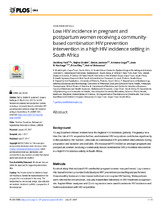| dc.contributor.author | Fatti, Geoffrey | |
| dc.contributor.author | Shaikh, Najma | |
| dc.contributor.author | Jackson, Debra | |
| dc.contributor.author | Goga, Ameena | |
| dc.contributor.author | Nachega, Jean B. | |
| dc.contributor.author | Eley, Brian | |
| dc.contributor.author | Grimwood, Ashraf | |
| dc.date.accessioned | 2018-10-31T09:01:22Z | |
| dc.date.available | 2018-10-31T09:01:22Z | |
| dc.date.issued | 2017 | |
| dc.identifier.citation | Fatti, G. et al. (2017). Low HIV incidence in pregnant and postpartum women receiving a community-based combination HIV prevention intervention in a high HIV incidence setting in South Africa. PLoS ONE ,12(7): e0181691. | en_US |
| dc.identifier.issn | 1932-6203 | |
| dc.identifier.uri | https://doi.org/10.1371/journal. pone.0181691 | |
| dc.identifier.uri | http://hdl.handle.net/10566/4171 | |
| dc.description.abstract | BACKGROUND
Young Southern African women have the highest HIV incidence globally. Pregnancy doubles
the risk of HIV acquisition further, and maternal HIV acquisition contributes significantly
to the paediatric HIV burden. Little data on combination HIV prevention interventions during
pregnancy and lactation are available. We measured HIV incidence amongst pregnant and
postpartum women receiving a community-based combination HIV prevention intervention
in a high HIV incidence setting in South Africa.
METHODS
A cohort study that included HIV-uninfected pregnant women was performed. Lay community-
based workers provided individualized HIV prevention counselling and performed
three-monthly home and clinic-based individual and couples HIV testing. Male partners
were referred for circumcision, sexually transmitted infections or HIV treatment as appropriate.
Kaplan-Meier analyses and Cox's regression were used to estimate HIV incidence and
factors associated with HIV acquisition.
RESULTS
The 1356 women included (median age 22.5 years) received 5289 HIV tests. Eleven new
HIV infections were detected over 828.3 person-years (PY) of follow-up, with an HIV incidence
rate of 1.33 infections/100 PY (95% CI: 0.74±2.40). Antenatally, the HIV incidence
rate was 1.49 infections/100 PY (95% CI: 0.64±2.93) and postnatally the HIV incidence rate
was 1.03 infections/100 PY (95% CI: 0.33±3.19). 53% of male partners received HIV testing
and 66% of eligible partners received referral for circumcision. Women within known serodiscordant
couples, and women with newly diagnosed HIV-infected partners, adjusted hazard
ratio (aHR) = 32.7 (95% CI: 3.8±282.2) and aHR = 126.4 (95% CI: 33.8±472.2) had
substantially increased HIV acquisition, respectively. Women with circumcised partners had
a reduced risk of incident HIV infection, aHR = 0.22 (95% CI: 0.03±1.86).
CONCLUSIONS
Maternal HIV incidence was substantially lower than previous regional studies. Communitybased
combination HIV prevention interventions may reduce high maternal HIV incidence in
resource-poor settings. Expanded roll-out of home-based couples HIV testing and initiating
pre-exposure prophylaxis for pregnant women within serodiscordant couples is needed in
Southern Africa. | en_US |
| dc.language.iso | en | en_US |
| dc.publisher | Public Library of Science | en_US |
| dc.rights | © 2017 Fatti et al. This is an open
access article distributed under the terms of the
Creative Commons Attribution License, which
permits unrestricted use, distribution, and
reproduction in any medium, provided the original
author and source are credited. | |
| dc.subject | Southern African women | en_US |
| dc.subject | HIV incidence | en_US |
| dc.subject | Risk of HIV acquisition | en_US |
| dc.subject | HIV prevention interventions | en_US |
| dc.title | Low HIV incidence in pregnant and postpartum women receiving a community-based combination HIV prevention intervention in a high HIV incidence setting in South Africa | en_US |
| dc.type | Article | en_US |
| dc.privacy.showsubmitter | FALSE | |
| dc.status.ispeerreviewed | TRUE | |
| dc.description.accreditation | ISI | |

